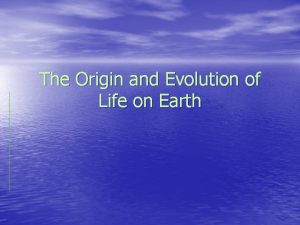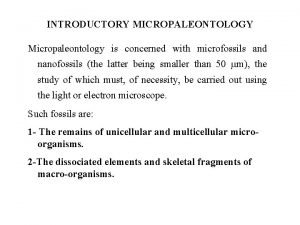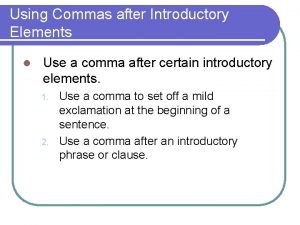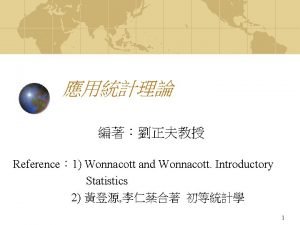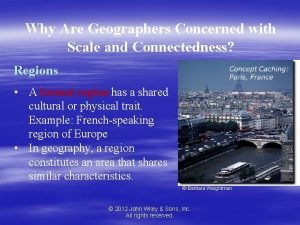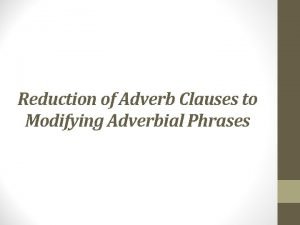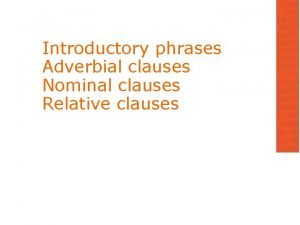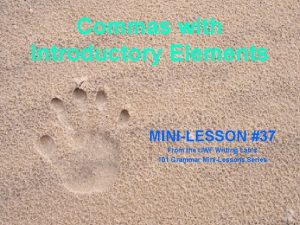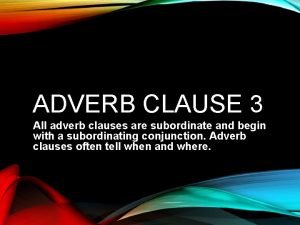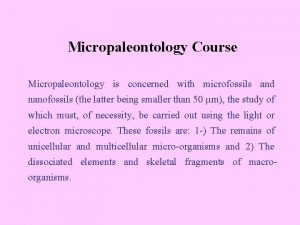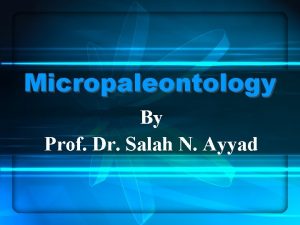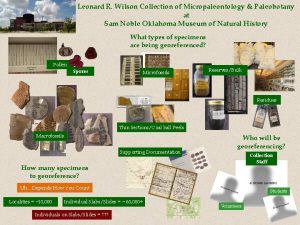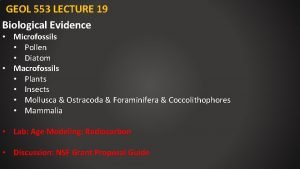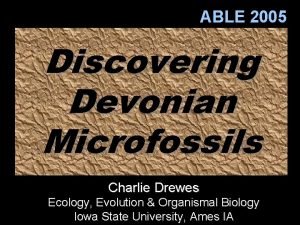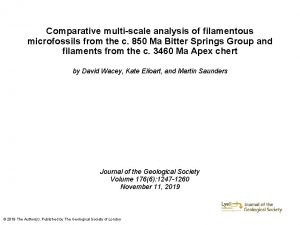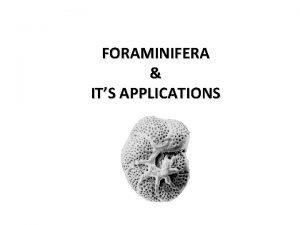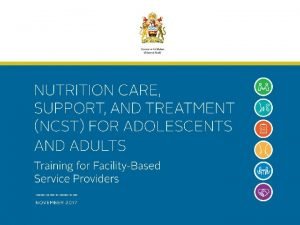INTRODUCTORY MICROPALEONTOLOGY Micropaleontology is concerned with microfossils and








































- Slides: 40

INTRODUCTORY MICROPALEONTOLOGY Micropaleontology is concerned with microfossils and nanofossils (the latter being smaller than 50 m), the study of which must, of necessity, be carried out using the light or electron microscope. Such fossils are: 1 - The remains of unicellular and multicellular microorganisms. 2 -The dissociated elements and skeletal fragments of macro-organisms.

Objective of micropaleontology 1 - Study the fossils in terms of morphology, structure, chemical and mineralogical components 2 - Classification: discover their origin and systematic affinities 3 - Application: (oil) exploration, biostratigraphy, palaeo -biology, paleoclimatology 4 - Environmental inferences

Microfossils Groups 1. Foraminifera Unicellular/ calcareous or agglutinated/ marine environments/ planktonic and benthonic/ heterotrophic. 2. Ostracods Multicellular/ calcareous or chitinous valves/ marine and fresh environments/ planktonic and benthonic/ heterotrophic. 3. Coccolithophora unicellular/ autotrophic/ calcareous/ planktonic and benthonic/ marine and fresh environments.

4. Diatoms 5. unicellular/ autotrophic/ siliceous/ planktonic/ mainly 6. marine environments. 5. Radiolaria 6. unicellular/ heterotrophic/ siliceous/ planktonic/ 7. marine environments. 6. Dinoflagellates 7. unicellular/ autotrophic or heterotrophic / cysts are 8. preserved (organic, calcareous or siliceous) motile and non 9. motile stages/ marine and fresh environments.


Foraminifera Phylum: Protozoa Subphylum: Sarcodina Class: Rhizopoda Order: Foraminiferida Foraminifera are single-celled animals protected by hard shells of different types of materials (chitinous, calcareous, agglutinatd, and siliceous). They are microscopic in size, and generally range from 0. 1 to 1 mm. (approximately the size of a grain of sand or smaller). However, in the geologic past, forams with test diameters greater than 10 cm. (4 in. ) were not unusual. Animal consists of: Cell (Soft parts of foraminifera) has: Protoplasm (surrounded by membrane) Protoplasm within the shell (test) = endoplasm (dark and granulous) contains: - 1 or more nuclei - systems for cell-secretion (Golgi) §

- systems for gas-exchange (Mitochondria) - systems for protein-synthesis (Ribosomes) - fluid or gas filled ‘ droplets’ (Vacuoles) Protoplasm outside the test = ectoplasm (transparent) forms pseudopodia § Pseudopodia Long strings of ectoplasm (2 -3 to 20 times test diameter) Can branch very often, shaping web-like appearance around the test. Surrounded by rather fluid layer Functions: 1 - Feeling objects changes in chemistry of the environment

2 - Food gathering and transport: (food particles caught and incorporated in the ectoplasm; transport of food to the endoplasm through aperture; transport of waste-products outward) 3 - Fixation and motion Benthic forams sessile or motile. Planktonic forams migrate without pseudopodiaaction---they move only by the effect of water current and gas-volume variation. 4 - Formation new chambers • Notes: students should see foram movie!

Pseudopodia network: they are dense and more frequent near the opening of the test

§ Life style Benthic forams live in/on sea floor sediments Planktonic forams free floating living in the sea surface water (0. 0 -200 m), occupying different depths; some occupy depths down to 700 m in the water column. Diagram showing live benthic foraminiferal style (Brasier, 1980)

Habitats of benthic foraminifera: 1. Epifaunal------(includes branched forms) from 0. 0 to 1 cm depth in the sediments. 2. Shallow infaunal-----from 1 to 2 cm depth in the sediments. 3. Intermediate infaunal-----from 2 to 3 cm depth in the sediments. 4. Deep infaunal----from 3 to 15 cm depth in the sediments.


§ Food Foraminifera are heterotrophic (mostly omnivorous) organisms in nutrition, some food examples: bacteria, coccolithophorids, diatoms, dinoflagellates, radiolarians, algae, parts of other plants, and other foraminifera. Some species are very selective feeders. Food generally digested in the endoplasm. Species with small apertures digest outside the test (feeding-cyste). Note: Spinose planktonic species are carnivorous/omnivorous and live close to the surface oligotrophic (low nutrients) water. Non-spinose planktonic species are herbivores live in deep water (below 200 m).

q Symbiosis Foraminifera make symbiosis with photosynthetic organisms (zooxanthellae) such as: Algae, Dinoflagellates and Diatoms. Zooxanthellae are separated from protoplasm by membrane; and what is its functions? Suggestions: 1 - Zoo. supply O 2 and carbohyderates, forams supplies CO 2 2 - Zoo. are for emergency ‘Lunch’ 3 - Zoo. consume excess Nitrogen-products 4 -Zoo. gain ‘mobility’ and ‘protection’ Day-night migration of symbionts within the protoplasm of planktonic forams, has been observed. Motion is along the spines, in/out via the aperture.

Some benthic foraminifera (e. g. Sorites sp. , Amphisorus sp. , Marginopora sp. and Permian fusulinids >10 cm) attain large sizes by help of symbiotic associations. The dinoflagellates continue to photosynthesize, as long as they have light and nutrients. However, they do not keep the products of photosynthesis for themselves. They release almost all of it into the tissues of the host. The host uses this energy as food, and typically has enough energy to add more and more calcium carbonate into its test. Does the symbiosis affect the isotopic signature (δ 18 O & δ 13 C) of the foraminiferal shells and then makes the climatic inferences difficult?

Image of Marginopora vertebralis Note the occurrence of symbionts (brown zone) in the inner part of the test avoiding the external digesting area (white zone).

Image of Orbulina universa Note that the test is surrounded by dinoflagellate symbionts. Juvenile trochospiral shells are visible in the center of the transparent spherical chamber.

q Life cycle Foraminifera resemble (certain) plants, having two phases of reproduction (heterophasic): 1. Asexual reproduction (schizogony)----( Microspheric form with numerous chambers = A-form) - Give young Gamont with half of the chromosome of the parent - Occurs in winter months 2. Sexual reproduction (gamogony)----megalospheric (A-form) -Give young Schizont with all of the chromosome of the parent - Occurs in summer months In planktonic foraminifera only sexual reproduction occurs

Diagram of benthic foraminiferal life history (Brasier, 1980)

q Wall structure and composition Chitinous wall: present in fresh-water benthic foraminifera. Agglutinated wall: -----only feature for benthic---foraminifer builds its test wall by cementing together exogenous grains (e. g. sand grains, oolites, fine grains of calcite or sponge spicule) by carbonate mineralization. Wall is a simple layer that grades from fine grains inside to coarse grains outside Calcareous (Ca CO 3) wall: present for both benthic and planktonic foraminifera: (hyaline or porcelaneous) Hyaline/glassy wall: transparent, perforate, crystals are radial, with lamellae (laminations) that separated by organic layers. Porcelaneous wall: shiny, smooth, crystals randomly arranged

Examples of wall structures in foraminifera (Brasier, 1980)

q Chamber growth and development 1 - Protoplasm moves gradually whereas test develops periodically at regular intervals 2 - Protoplasm (pseudopodia) occupies the space of the new chamber, then organic wall builds, then finally agglutinated or calc. materials add in the outer side or on both sides. Foraminiferal tests may be unilocular or multilocular In multilocular tests, if the last formed chamber does not overlap the previous one, wall will be non-laminar. If the last formed chamber overlaps the previous one, wall will be bi or multilaminar.

Non-laminar and multilaminar walls in foraminifera (Brasier, 1980).

q General classification and test morphology 1 - Suborder Allogromiina: 2 - Suborder Textulariina: 3 - Suborder Fusulinina: 4 - Suborder Miliolina: 5 - Suborder Rotaliina: (contains many superfamilies) Superfamily: Nodosariacea Superfamily: Buliminacea Superfamily: Discorbacea Superfamily: Orbitoidacea Superfamily: Spirillinacea Superfamily: Duostominacea Superfamily: Robertinacea Superfamily: Globigerinacea Superfamily: Rotaliacea Superfamily: Cassidulinacea Superfamily: Carterinacea

Images of suborder Allogromiina: a) Allogromia; b) Shepheardella Images of suborder Textulariina (superfamily Ammodiscacea): c) Rhabdammina; d) Technitella; e) Sorosphaera; f) Saccammina and g) Tolypammina. From Brasier, 1980.

Images of suborder Textulariina (superfamily Lituolacea): a) Coskinolina; b) Cyclolina; c) Cyclopsinella; d) Dicyclina; e) Orbitolina. From Brasier, 1980.

Images of suborder Textulariina (superfamily Lituolacea): a) Reophax; b) Hormosina; c) Miliammina; d) Cyclammina; e) Loftusia; f) Spirocyclina. From Brasier, 1980.

Images of suborder Textulariina (superfamily Lituolacea): a) Ammobaculite; b) Textularia; c) Bigenerina; d) Verneuilina; e) Trochammina. From Brasier, 1980.

Images of suborder Fusulinina (superfamily Parathuramminacea): a) Saccaminopsis and b) Earlandinita. Superfamily Endothyracea: c) Nodosinella; d) Palaeotextularia; e) Tetrataxia. From Brasier, 1980.

Foraminiferal bioenvironmental indicators q PHYSICAL PROPERTIES: 1 - Water depth ----indirect---organic matter (food) decreases with increasing water depth 2 - Temperature----indirect---increasing T° leads to salinity increases---more stratification in the water column---then less oxygen at deeper sites 3 - Light---indirect---important for algae (photosynthesis) that make symbiosis with foraminifera 4 - Water currents directly inhibit the benthic foraminifera to build their habitat in/on the sea floor.

q CHEMICAL PROPERTIES: 1 - Salinity (‰ = parts per thousand) ---- foraminifera can live in all aquatic environments such as: - Fresh water (0. 0 -0. 5‰)-----rivers and estuaries such as: Allogromiidae. - Brackish water (0. 5 -30‰)--- lagoons and marshes such Ammonia and miliolids - Normal sea water (35 -45‰) is suitable for all other as: species. -Hypersaline water bodies (up to 57‰)----closed seas, lakes, lagoons and marginal bays. Such environment is lethal and destructive for any kind of living foraminifera. Notes: High diversity and high abundance of benthic foraminifera occur under normal seawater and the lower the salinity of an environment, the lower the diversity of benthic foraminifera is there.

2 - Alkalinity (p. H): Normal sea water has p. H of about 8. 1 that favors the Ca CO 3 precipitation (foraminiferal shells) as a result of availability of both Ca and CO 3 -2. p. H is governed by temperature, pressure and biological activities. Alkalinity decreases with increases water depth (= increasing CO 2 pressure and decreasing T°), as a result acidity increases leading to Ca CO 3 dissolution. p. H of the euphotic zone increases during the day and decreases during the night. Stagnant water (high POM fluxes) is characterized by acidic p. H’s.

The corrosiveness of a water mass toward Ca CO 3 increases as it moves along the path of thermohaline circulation. CCD = Calcite compensation depth: rain rate of Ca CO 3 (shell) equals the solubility (dissolution) of Ca CO 3. CCD in ocean waters after Haq and Boersma (1978).

3 - Nutrients (food): ³ High amount of nutrients (food) = high numbers of benthic foraminifera ³ An excess of nutrients is harmful on benthic foraminifera as a result of uptake of dissolved oxygen in remineralization processes. ³ High density and diversity of benthic foraminifera occur at areas receiving more amounts of food and dissolved oxygen.

4 - Dissolved oxygen v Depends on ocean circulation and fluxes of organic matter to the sea floor. v High oxygen indicates good circulation and no excess of organic matter. This conditions lead to high faunal density and diversity. v Low oxygen indicates stagnant water with more fluxes of organic matter on the sea floor. Thus conditions lead to anoxia and then to low faunal density and diversity. v Amount of dissolved oxygen is inversely related with the amount of the organic matter.

q BIOTIC VARIABLES: è Predation: worms, crustaceans, gastropods, echinoderms feed on foraminiferal tissues by boring holes into the foraminiferal tests in order to extract the protoplasm. è Symbiosis: algal symbionts help foraminifers to attain very large sizes. During algal blooms, foraminifers are abundant than any other seasons. è Food availability (nutrients) and dissolved oxygen are the most important variables at deep-sea environments. High amount of nutrients (food) = high numbers of benthic foraminifera. An excess of nutrients is harmful on benthic foraminifera as a result of uptake of dissolved oxygen in remineralization processes. è High density and diversity of benthic foraminifera occur at areas receiving more amounts of food and dissolved oxygen.

1. 2. 3. Planktonic Foraminiferal bioenvironmental indicators TEMPERATURE: planktonic foraminifers are temperature indicators - Spinose species live in shallow, warm surface water (0 - 75 m). - Non-spinose species live mostly in (colder) deeper waters, down to some 500 m. HYDROGRAPHY: planktonic foraminifera flourish and become more abundant at eddies, turbulent zones and upwelling areas. FOOD AVAILABILITY: plank. foram. are abundant and diverse at areas of high nutrients (food) such as eddies, turbulent zones and upwelling regions. Spinose species prefer oligotrophic (low food) waters. Non-spinose species prefer eutrophic (rich by nutrients) water.

Distribution of planktonic foraminifera It is geographically distributed and controlled mostly by temperature, water circulation and food availability. Tropical (24 -30ºC) Subtropical (20 -24ºC) Transitional (10 -18ºC) Subpolar (5 -10ºC) Polar (0 -5ºC)

Geographical distribution of planktonic foraminifera (Haq and Boersma, 1978).

Geographical distribution of planktonic foraminifera (Haq and Boersma, 1978).
 Microfossils
Microfossils Micropaleontology
Micropaleontology Micropaleontology definition
Micropaleontology definition Lesson 1-1 variables and expressions answer key
Lesson 1-1 variables and expressions answer key Unit 1 introductory lesson 1- variables and expressions
Unit 1 introductory lesson 1- variables and expressions Conclusion sentence for intro paragraph
Conclusion sentence for intro paragraph Comma explanation
Comma explanation Commas and introductory phrases
Commas and introductory phrases Wonnacott and wonnacott introductory statistics pdf
Wonnacott and wonnacott introductory statistics pdf Introductory chemistry concepts and critical thinking
Introductory chemistry concepts and critical thinking Signal phrase examples
Signal phrase examples Why are geographers concerned with scale and connectedness?
Why are geographers concerned with scale and connectedness? Why are geographers concerned with scale and connectedness?
Why are geographers concerned with scale and connectedness? Introductory paragraph format
Introductory paragraph format Introductory phrases examples
Introductory phrases examples Introductory paragraph for persuasive essay
Introductory paragraph for persuasive essay It is an introductory section of a news story
It is an introductory section of a news story An example of an introduction
An example of an introduction Desert paragraph
Desert paragraph Reduction of adverbial clauses exercises
Reduction of adverbial clauses exercises Introductory atlas ti course
Introductory atlas ti course Introductory paragraph literary analysis
Introductory paragraph literary analysis Adverbial clause definition
Adverbial clause definition Main character in the necklace
Main character in the necklace Introductory chemistry 4th edition
Introductory chemistry 4th edition Introductory chemistry 5th edition nivaldo j. tro
Introductory chemistry 5th edition nivaldo j. tro Introductory chemistry 5th edition nivaldo j. tro
Introductory chemistry 5th edition nivaldo j. tro Onedrive uniovi
Onedrive uniovi Introduction paragraph format
Introduction paragraph format What is a introductory element
What is a introductory element Army traffic safety course
Army traffic safety course Anecdote paragraph example
Anecdote paragraph example Chapter 2 descriptive statistics answer key
Chapter 2 descriptive statistics answer key Introductory rite
Introductory rite Introduction paragraph strategies
Introduction paragraph strategies How to start an introduction paragraph
How to start an introduction paragraph Introductory adverb clause
Introductory adverb clause Comma introductory clause
Comma introductory clause Snipes troy
Snipes troy Activity 1 introductory activity
Activity 1 introductory activity Performance review institute inc
Performance review institute inc
